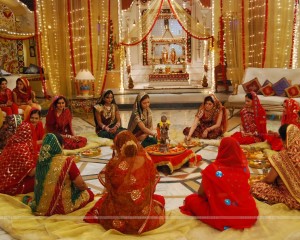
Indian-born, Anju grew up in Hong Kong and has also lived in Australia, Singapore, India and USA. Her fiction explores how cultures and traditions affect people values, beliefs and behavior patterns in today’s shrinking smart-world. She hopes to bridge cultures and break barriers one book at a time. ‘Duty and Desire’, the debut in Anju’s ‘Winds of Fire’ series, is available worldwide in hardcopy and on Kindle, Nook, Kobo and Apple.
Every year thousands of married Hindu women fast from dawn until moonrise to celebrate Karva Chauth, a festival to celebrate for the long-life and well-being of their husbands. On the 4th day of the full moon in the Kartik month, from October – November, women dress up in auspicious and dazzling colors like red, pink, gold, silver and maroon to celebrate their marriage, offer prayers and seek the welfare and prosperity of their husbands.
Mehendi, the fine art of henna tattoos, marks its flowery vines on the hands of many women along with colorful bindis dotting their foreheads, bangle-decked wrists, vermilion in the hair-parting and layers of jewelry cascading with the drapes of heavily embroidered saris. The celebration begins in the morning when women, observing the fast, begin their day without a drop of water or morsel of food, and continue with the fast until prayers to Goddess Parvati and Lord Ganesha in the evening.
Popular in the northern and western regions of India, especially Haryana, Punjab, Rajasthan, Uttar Pradesh and Gujarat, hundreds and thousands of Hindu women, world-wide, fill an urn with water, flowers, and seal the open mouth of this karva with a red cloth. Puja thaalis, prayer platters, are filled with tiny pools of red vermilion powder, rice, the karva and a diya—a crucible lit with a cotton wick and filled with oil—and used to perform the evening ceremony. Women usually congregate at someone’s home, and a leader recites the Vrat Katha. After the evening prayers women then worship the moon only after it has risen. They observe the moon through the pores of a sieve and then view their husband’s face through the same, and break the fast by taking the first few sips of water from the husband’s hand.
Romantic as it sounds, this celebration varies from state to state with colors that run as deep as the hues of saris worn for the occasion. In Punjab, for example, Karva Chauth is the most important festival for married women. The markets are flooded with beautiful saris, bangles and sweet-meats. Artists from Jaipur, Agra and Delhi set up henna stalls in the rush to decorate the hands of married women for this festival. In some areas of Punjab, bachelorettes fast on this day in the hope of winning a loving husband.
In Rajasthan, Karva Chauth takes on a different meaning. Women from this state fill their karvas with grains of rice, wheat, some cardamom, cloves and a silver coin, and wear their wedding saris (or chunris) on this day. They don’t have a lit diya adorning their puja thaalis or observe the moon and then their husbands through the pores of a sieve. They can drink water throughout the day and have fruits and milk once during the day. Though Karva Chauth is widely celebrated here, ‘Teej’, which falls in August, is more popular. Women from this state believe that by fasting on Karva Chauth not only do they secure the welfare for their husband but also the same husband for the next 7 births. They break the fast after moon rise but sip the first drop of water from their mother-in-law’s hand.
 In Utter Pradesh women decorate the walls of their homes with drawings of Gauri Ma, the moon and the sun. They pray to these figurines before worshipping the moon at moonrise.
In Utter Pradesh women decorate the walls of their homes with drawings of Gauri Ma, the moon and the sun. They pray to these figurines before worshipping the moon at moonrise.
In Mahrashtra this festival is celebrated, but not as popular as ‘Vaat Savitri’ performed by married women.
Despite its variations and differing beliefs, Karva Chauth is marked, for the majority, without food or water. The celebration stems from a deep-seated desire for the welfare of the husband through fasting and prayer. And the return is a tradition that has continued to prosper despite changing echelons of society, westernization of India or its globalization.
If anything Karva Chauth has now earned more global recognition than it ever did before.
Find Anju Gattani @ www.anjugattani.com